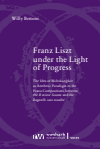Franz Liszt under the Light of Progress
The Idea of Mehrdeutigkeit as Aesthetic Paradigm in the Piano Compositions between the B minor Sonata and the Bagatelle sans tonalité
Abstract
The idea of progress became increasingly relevant during the 19th century, eventually instigating a paradigm shift. This transformation facilitated not only the emergence of numerous philosophical and literary trends, but also engendered new perspectives in music theory. The composer Franz Liszt was also influenced by the spirit of the epoch. This study’s analysis of his piano compositions from the Sonata in B Minor to the Bagatelle sans tonalité shows how he shaped and adapted his musical language and aesthetic thinking on the basis of what he called the ‘ideal of the time’.
Zusammenfassung
Der Begriff des Fortschritts gewann im 19. Jahrhundert immer mehr an Bedeutung, sodass es zu einem Paradigmenwechsel kam. Diese Veränderung brachte nicht nur zahlreiche philosophische und literarische Strömungen hervor, sondern ebenfalls neue Perspektiven in die Musiktheorie. Auch der Komponist Franz Liszt wurde vom Geist der Epoche geprägt. Die Analyse seiner Klavierkompositionen von der h-Moll Sonate bis zur Bagatelle sans tonalité zeigt, wie er, anhand von dem, was er »Ideal der Zeit« nannte, seine musikalische Sprache und seinen ästhetischen Gedanken gestaltete.
Schlagworte
19. Jahrhundert Aux cyprès de la Villa d'Este S163/3 Berlioz und seine Harold-Symphonie Es muss sein! Fortschritt h-Moll Sonate La lugubre gondola S200/1 late piano works Lisztian Pantheon Nuages gris S199 progress Romanticism Romantik Unstern! – Sinistre S208 Waldesrauschen S145/1 Franz Liszt Klavier Musikästhetik- 11–30 I Introduction 11–30
- 11–12 The problem Liszt 11–12
- 309–318 VII Conclusion 309–318
- 319–336 ANNEXES 319–336
- 337–346 Bibliography 337–346
- 347–348 Acknowledgements 347–348

